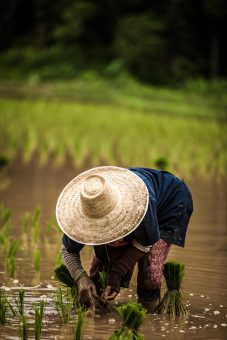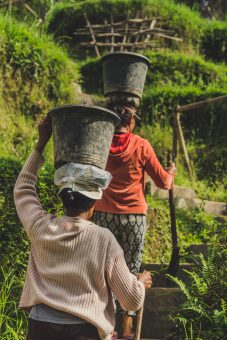
Madagascar has a rich history of rice cultivation. Outside of Asia, Madagascar has the longest tradition of rice production, and this staple is cultivated in almost all districts of the country. For the Malagasy people, rice is a core part of their diet: many families eat it three times a day, and most of it is homegrown. On special occasions, Ranonapango may be served – a traditional drink made from toasted rice and boiling water.
In Madagascar, however, people earn less than US 1.90 per day on average, and the Malagasy population is severely affected by food insecurity, including food shortages. Domestic production of rice, for example, still does not meet the needs of the island, and the country has to rely heavily on imported rice to help ensure national food security.
Hopefully, not for much longer however: Madagascar has set itself the goal of being rice self-sufficient by the end of 2020.
Cooperation, cooperation, cooperation
To work towards this, an FAO South-South Cooperation project began in late 2019 between China and Madagascar. Chinese experts on rice production came to Madagascar to introduce a greater-yielding type of rice, as well as to provide training to farmers on how to grow and harvest it.
The new kind of rice seeds are better suited to the Malagasy subtropical climate, which consists of a hot and rainy season between November and the end of March and a cooler dry season from May to October. This Weichu rice variety has been especially developed to fit the climatic and soil conditions of Madagascar.
Modeste Rabenarivo is a 54-year-old rice farmer from Mahitsy in central Madagascar, where he has a 3 000 square metre plot of land. He has always been very interested in new farming techniques and methods, and when the FAO project began nearby, the idea of growing a new variety of rice piqued his interest.
“As soon as I learned that [the rice] could yield eight, nine or ten tonnes per hectare, I immediately joined the project,” Modeste says.
More:
Across three areas of the island, 124 rice farmers took part in the project, working together with a Chinese expert team, to benefit from both theoretical and field training on rice cultivation. So far, the participants are happy with the results.
“What reassures me about this rice,” Modeste continues, “is that the two-month-old plants already have more than six leaves, so they’re already growing well.”
“After training on seed preparation, as well as nursery management like water control, fertilizer supply and use of products against insects, critters and weeds, I had the idea of transplanting earlier to see the potential of this rice. I am motivated to adopt this variety,” Modeste enthuses.
To date, the harvest has yielded approximately 8.45 tonnes on average per hectare compared to the 2.8 tonnes per hectare that was harvested before the project. Alain Randrianarivelo, who has farmed rice for more than 20 years, says, “I think this new variety of rice is the future of our agriculture. The yield obtained is breathtaking.”
Self-sufficiency – for 2020 and after
The South-South project is not just concentrated on the three pilot areas, it also aims to have a long-term effect on rice-growing in Madagascar in general. To this end, technicians from Madagascar’s Ministry of Agriculture, Livestock and Fishery have also taken part in the training, in order to implement the approach in other areas of the country. Nearly 70 managers and technicians from the Regional Directorate of Agriculture, Livestock and Fisheries also followed these training courses in the field in order to better disseminate the techniques. The project aims to train at least 1 000 farmers, in order to bring the average rice yield up from 2.8 tonnes per hectare to between 8 and 12 tonnes.

Government minister Lucien Ranarivelo is positive about the South-South collaboration with China, stating: “This technology is widely used in several countries and is one of the conditions that has allowed China to be self-sufficient in food. The collaboration affects the technical aspects of seed production in Madagascar; training is provided, and we apply this training and use the seeds directly.”
For Modeste, an increased production from his rice fields would mean the world. As a father of three, it would mean being able to send his children to school, a feat not all farmers can manage. It also means that in the long run, he can save some money and do less strenuous activities for his retirement.
For Madagascar as a country, this new variety will allow it to be self-sufficient by significantly reducing the level of rice imports.
In the aftermath of the global COVID-19 pandemic, the positive effects will play an even more important role: food production self-sufficiency, which guarantees food security, is key in the recovery plan.
FAO’s South-South cooperation projects encourage countries to share expertise, knowledge and solutions. Working together is key to creating a stronger, more resilient global agricultural sector, improving food security and livelihoods for all.
Source: FAO

